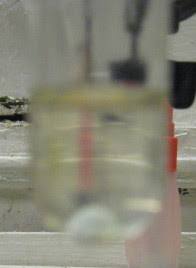
{big snip}
the overall reaction would be
Mg + 2KOH -> Mg(OH)2 + 2K (wrong) (2)
meaning no hydrogen is evolved (and using up 1/2 less magnesium for the same amount of K generated), contrary to experiment, which shows hydrogen to be evolved at a rate close to (1) above.
[Edited on 20-12-2010 by len1]


 . I'll think about this and carefully read all of this thread again and see if I can make a start with this one of the next upcoming days.
. I'll think about this and carefully read all of this thread again and see if I can make a start with this one of the next upcoming days.



 ..... Im also sensing a low temperature Phosphorus production variant stemming from
this reaction something in the future.
..... Im also sensing a low temperature Phosphorus production variant stemming from
this reaction something in the future.
 the next time instead of a stupid balloon. Of course,
this will only work as long as you don't change the temperature of your mix up and down very often. If you do so: air would bubble from the outside
despite (or because of) using such a bubbler because of increasing and decreasing pressure in your reactor. The same effect may occure at occasionally
swirling the reactor (cooling down while taking and swirling it -> decrease of pressure -> influx of air through the bubbler) Hydrogen evolution
within the 4 hours of reaction can be very slow and will not guarantee a constant efflux! But if you keep the temperature quite constant it will work
very well, I think.
the next time instead of a stupid balloon. Of course,
this will only work as long as you don't change the temperature of your mix up and down very often. If you do so: air would bubble from the outside
despite (or because of) using such a bubbler because of increasing and decreasing pressure in your reactor. The same effect may occure at occasionally
swirling the reactor (cooling down while taking and swirling it -> decrease of pressure -> influx of air through the bubbler) Hydrogen evolution
within the 4 hours of reaction can be very slow and will not guarantee a constant efflux! But if you keep the temperature quite constant it will work
very well, I think. 
